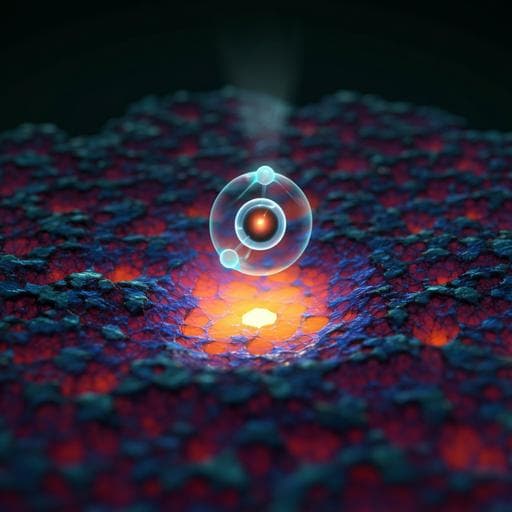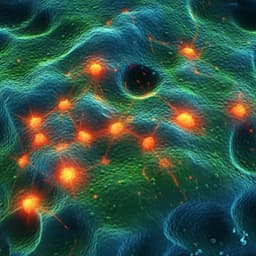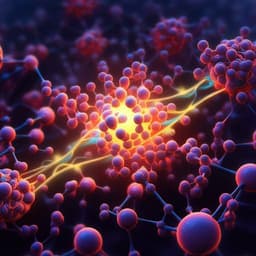
Chemistry
Selectively anchoring single atoms on specific sites of supports for improved oxygen evolution
Z. Zhang, C. Feng, et al.
This groundbreaking research by Zhirong Zhang and colleagues explores the strategic placement of Ir single atoms on CoOOH surfaces to enhance oxygen evolution reaction (OER) activity. Discover how different anchoring sites dramatically impact electronic interactions and performance, with Ir1/Vo-CoOOH leading the charge in efficiency.
~3 min • Beginner • English
Introduction
Single-atom catalysts (SACs) offer maximized atom efficiency and uniform active sites, but their true homogeneity depends on identical metal–support interactions, which is difficult to achieve on realistic supports with varied topologies and defects. The local coordination environment significantly affects catalytic behavior, as shown in prior studies where different ligation or neighboring atoms tuned metal oxidation states and adsorption properties. CoOOH surfaces present multiple potential anchoring sites (three-fold fcc and hcp oxygen hollow sites and oxygen vacancies). The research question is whether selectively anchoring identical single atoms (Ir) at specific, well-defined sites on a defective CoOOH support can systematically modulate and improve oxygen evolution reaction (OER) performance, and what mechanisms govern these site-dependent effects. The study aims to use electrochemical deposition to direct Ir single atoms to distinct sites and to correlate anchoring site, electronic/geometric structure, and OER activity.
Literature Review
Prior works established the importance of coordination environment in SACs: Fe single atoms coordinated to different N species exhibit different oxidation states and adsorption to CO2; Pt single atoms coordinated with N versus Mo alter d-band depletion and oxygen-intermediate binding. Electrostatic adsorption methods in alkaline media yield both cationic and hydroxylated anionic metal precursors, suggesting site-selective anchoring driven by electric fields. Co-based oxyhydroxides are established OER platforms with known surface defects (oxygen vacancies) and vibrational signatures. Theoretical and experimental studies indicate mononuclear Ir sites are generally inactive for OER, often requiring adjacent sites, and conventional OER mechanisms involve adsorbed *OH, *O, and *OOH intermediates with O–O formation as a common rate-determining step. These insights motivate precise placement of single atoms to tune local interactions and reaction energetics.
Methodology
- Support synthesis: CoOOH nanosheets prepared by co-precipitation. Co(NO3)2·6H2O aqueous solution was alkalinized with NaOH, then oxidized with NaOCl, isolated, washed, and freeze-dried. Characterized by TEM, EDX, XRD (peaks at 20.1°, 38.9°, 50.5° for (003), (012), (015)), ESR (g = 2.01 indicating oxygen vacancies), and XPS (O 1s deconvolution showing adsorbed H2O, oxygen vacancies, Co–OH, Co–O; Co 2p indicating Co2+/Co3+).
- Site-selective single-atom deposition: Electrochemical deposition in a three-electrode cell (glassy carbon working, carbon rod counter, Ag/AgCl reference) in alkaline electrolyte with 100 µM IrClx precursor. Catalyst ink: CoOOH with carbon, water/alcohol, Nafion.
• Ir1/To-CoOOH (cathodic): Pretreat 0.10 to −0.40 V (10 cycles), then deposit Ir by linear sweeps 0.10 to −0.40 V, 5 mV s−1, repeated 10 times. Drives cationic IrCl3+ species to three-fold fcc oxygen hollow sites.
• Ir1/VO-CoOOH (anodic): Pretreat 1.10 to 1.80 V (5 cycles), then deposit Ir by linear sweeps 1.10 to 1.80 V, 5 mV s−1, repeated 5 times. Drives anionic Ir(OH)2− species to oxygen vacancies. Samples washed and used for testing. Potentials converted to RHE.
- Characterization of single-atom dispersion and coordination: HAADF-STEM with fixed projection, EDX mapping, ICP-AES for Ir loading (~1.2–1.3 wt%). XANES at Ir L3-edge for valence states, EXAFS to resolve first-shell coordination (Ir–O, Ir–Cl) and absence of Ir–Ir; XPS for Cl, O, Co; Co L-edge XAS to probe Co valence and metal–support charge transfer; in-situ XANES/EXAFS (Ir L3, Co K) and Raman under applied potentials.
- Electrochemical OER testing: 1.0 M KOH, LSV 1.10–1.80 V vs RHE at 5 mV s−1, iR correction (R = 9 Ω). Faradaic efficiency measured in H-cell with GC. ECSA from double-layer capacitance (smooth oxide 60 µF cm−2). Specific/mass activities normalized by ECSA, CoOOH mass, or Ir mass. Tafel slopes from η = a + b log j. EIS at 1.57 V (5 mV amplitude, 100 kHz–0.05 Hz). Chronopotentiometry at 10 mA cm−2 for 20 h. Controls: CoOOH subjected to cathodic/anodic treatments without Ir deposition.
- DFT calculations: VASP 5.4, PAW, RPBE+D3, Ueff = 3.3 eV on Co, cutoff 520 eV, spin-polarized, 3×3×1 k-point mesh, slab with ≥15 Å vacuum, bottom layer fixed. Models: IrCl3+ on fcc/hcp/vacancy sites and Ir(OH)2 on the same; formation energies computed to rationalize site preference. PDOS for Co 3d band structure changes. OER thermochemistry via computational hydrogen electrode; free energies of *OH, *O, *OOH with ZPE and entropy corrections; theoretical overpotential from max ΔGi/e − 1.23 V. RDS energy barriers compared on Co sites for CoOOH, Ir1/To-CoOOH, Ir1/VO-CoOOH. Coverage effects tested with 4×4 supercell.
Key Findings
- Site-selective anchoring achieved:
• Ir1/To-CoOOH (cathodic) places Ir at three-fold fcc oxygen hollow sites with IrCl3O3 coordination (Ir–O CN ≈ 3.3; Ir–Cl CN ≈ 3.2). Ir valence between +3 and +4; Cl detected by XPS (Cl 2p3/2 at 198.3 eV). Strong metal–support interaction increases Co valence (Co L-edge XAS shift).
• Ir1/VO-CoOOH (anodic) anchors Ir at oxygen vacancies with IrO6 coordination (Ir–O CN ≈ 5.9), Ir valence slightly >+4; no Cl detected; oxygen vacancy concentration decreases due to site occupation. Weak Co–Ir charge transfer (Co L-edge unchanged).
• EXAFS shows no Ir–Ir peak (~2.71 Å), confirming isolated atoms in both.
• DFT formation energies: IrCl3+ most stable on fcc site (−0.86 eV), less stable on hcp (+0.46 eV higher) and vacancy (+2.74 eV higher than fcc). Ir(OH)2− most stable at vacancy (−1.44 eV) vs fcc (+1.13 eV) and hcp (+1.06 eV).
- OER performance in 1.0 M KOH:
• Overpotential at 10 mA cm−2: Ir1/VO-CoOOH 200 mV, 70 mV lower than Ir1/To-CoOOH; both outperform CoOOH and commercial IrO2. Faradaic efficiency >99%.
• Specific activity (ECSA-normalized) at η = 300 mV: Ir1/VO-CoOOH 17.3 mA cm−2, 5.75× Ir1/To-CoOOH.
• Mass activity normalized to CoOOH at η = 300 mV: Ir1/VO-CoOOH 605.4 A gCoOOH−1, 5.84× Ir1/To-CoOOH. Normalized to active CoOOH adjacent to Ir or to Ir loading: ~5.40× higher for Ir1/VO-CoOOH.
• TOF at η = 300 mV: based on Co sites, Ir1/VO-CoOOH 0.144 s−1 vs Ir1/To-CoOOH 0.025 s−1 (5.76×); based on Ir sites, 5.39× higher for Ir1/VO-CoOOH.
• Tafel slopes: CoOOH 73 mV dec−1; Ir1/To-CoOOH 65 mV dec−1; Ir1/VO-CoOOH 32 mV dec−1, indicating fastest kinetics for vacancy-anchored Ir.
• EIS: Ir1/VO-CoOOH shows smaller semicircle (lower interfacial charge-transfer resistance) than Ir1/To-CoOOH.
• Stability: Ir1/VO-CoOOH maintains potential at 10 mA cm−2 for 20 h; post-test retains single-atom dispersion (HAADF-STEM), Ir loading ~1.29% (≈ initial 1.3%).
- In-situ spectroscopy:
• Increasing applied potential raises Ir and Co valence (Ir L3, Co K-edge XANES) with small Co edge shifts (<0.5 eV), indicating stability. Co–O and Co–Co EXAFS peaks remain at ~1.46 Å and ~2.44 Å across potentials. Raman peak at 499 cm−1 (Eg Co–O) persists, confirming CoOOH phase stability.
- Mechanistic and electronic insights:
• PDOS: Ir1/To-CoOOH introduces Co 3d edge states, narrowing bandgap from 1.8 eV (CoOOH) to 0.8 eV, favoring electron transfer; Ir1/VO-CoOOH bandgap remains ~1.8 eV.
• DFT free-energy analysis (Co site as active center; Ir mononuclear sites inert): RDS is O–O bond formation (*O → *OOH). RDS energy barriers at U = 0 V: CoOOH 2.20 eV; Ir1/To-CoOOH 2.08 eV; Ir1/VO-CoOOH 1.63 eV. Similar results at U = 1.23 V with identical overpotentials. Coverage effects minimal (≤0.05 eV change in 4×4 model).
• Adsorption energetics: Ir1/To-CoOOH strengthens adsorption of *OH, *O, *OOH vs CoOOH due to higher Co valence (stronger electron affinity), but not optimal. Ir1/VO-CoOOH introduces hydrogen bonding between intermediates (*OH, *OOH) and the oxygen coordinated to Ir (Ir(OH)), stabilizing key intermediates and enabling near-optimal energetics; deprotonation of *OOH to *OO further stabilizes intermediates and aligns with faster kinetics (lower Tafel slope).
Discussion
Selective anchoring of Ir single atoms at distinct surface sites on CoOOH yields different metal–support interactions and thus different OER enhancement mechanisms. Three-fold fcc anchoring (Ir1/To-CoOOH) induces strong electronic coupling and charge transfer from Co to Ir, narrowing the bandgap and strengthening adsorption of all oxygenated intermediates on Co sites; this lowers the RDS barrier modestly but can lead to over-binding. In contrast, vacancy anchoring (Ir1/VO-CoOOH) does not significantly alter the Co electronic structure but provides a nearby Ir–O moiety that forms hydrogen bonds with *OH and *OOH, selectively stabilizing these intermediates and reducing the O–O formation barrier substantially. The hydrogen-bond-assisted pathway accelerates kinetics (32 mV dec−1) and yields superior activity (η10 = 200 mV, high specific and mass activities) while maintaining structural stability under operating conditions. These findings directly answer the research question by demonstrating that precise control over single-atom anchoring sites can tailor reaction energetics and kinetics via electronic versus configurational effects, offering a route to truly homogeneous and optimized SAC active environments.
Conclusion
The study establishes an electrochemical deposition strategy to site-selectively anchor Ir single atoms on defective CoOOH either at three-fold fcc oxygen hollow sites (via cathodic deposition of IrCl3+) or at oxygen vacancies (via anodic deposition of Ir(OH)2−). Both catalysts outperform pristine CoOOH and IrO2 in alkaline OER, with vacancy-anchored Ir (Ir1/VO-CoOOH) delivering the best performance (η10 = 200 mV, Tafel 32 mV dec−1, >5× higher specific/mass activity and TOF than fcc-anchored Ir). Mechanistically, fcc anchoring enhances activity through electronic modulation (bandgap narrowing and stronger adsorption), while vacancy anchoring operates via configurational interactions (hydrogen bonding) that optimally stabilize *OH/*OOH and lower the RDS barrier (1.63 eV). The work links anchoring-site control to catalytic mechanisms, guiding rational SAC design. Future directions include extending the site-selective anchoring concept to other metals and supports, exploring multi-atom cooperative sites, and integrating kinetic modeling beyond thermodynamic descriptors to refine catalyst screening.
Limitations
- The DFT-based activity assessment relies on thermodynamic free-energy differences and the computational hydrogen electrode; kinetic activation barriers and solvent/field effects are not explicitly computed, so the potential-determining step is treated as equivalent to the rate-determining step.
- Mononuclear Ir sites were found inert on N-doped carbon, and the active site was modeled as adjacent Co on CoOOH; generalization to other supports or varying local environments may require further validation.
- Experimental evaluation focused on alkaline media (1.0 M KOH); performance and mechanisms in different electrolytes or pH may differ.
- The precise atomic configuration under operando conditions is inferred from in-situ spectroscopy and DFT models; transient restructuring or dynamic bonding not captured could influence activity.
Related Publications
Explore these studies to deepen your understanding of the subject.







